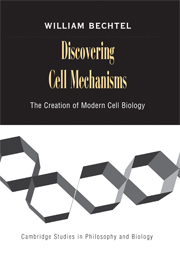Book contents
- Frontmatter
- Contents
- Preface
- 1 Introduction: Cell Mechanisms and Cell Biology
- 2 Explaining Cellular Phenomena through Mechanisms
- 3 The Locus of Cell Mechanisms: Terra Incognita between Cytology and Biochemistry
- 4 Creating New Instruments and Research Techniques for Discovering Cell Mechanisms
- 5 Entering the Terra Incognita between Biochemistry and Cytology: Putting New Research Tools to Work in the 1940s
- 6 New Knowledge: The Mechanisms of the Cytoplasm
- 7 Giving Cell Biology an Institutional Identity
- Afterword
- References
- Index
1 - Introduction: Cell Mechanisms and Cell Biology
Published online by Cambridge University Press: 05 June 2012
- Frontmatter
- Contents
- Preface
- 1 Introduction: Cell Mechanisms and Cell Biology
- 2 Explaining Cellular Phenomena through Mechanisms
- 3 The Locus of Cell Mechanisms: Terra Incognita between Cytology and Biochemistry
- 4 Creating New Instruments and Research Techniques for Discovering Cell Mechanisms
- 5 Entering the Terra Incognita between Biochemistry and Cytology: Putting New Research Tools to Work in the 1940s
- 6 New Knowledge: The Mechanisms of the Cytoplasm
- 7 Giving Cell Biology an Institutional Identity
- Afterword
- References
- Index
Summary
In order to succeed in solving these various problems, one must so to speak progressively dismantle the organism, as one takes to pieces a machine in order to recognize and study all its works.
(Bernard, 1865, Part II, Chapter 1)A different kind of science
To many people, cell biology is an unlikely domain to impart impetus for a major shift in the way philosophy of science is practiced. Cells appear to be the object of straightforward empirical observation, not of bold theories that challenge the status quo. In high school or at the museum you look into the microscope and struggle to see what you are told you should see – structures that are never as sharp and well delineated as in the drawings in textbooks. What could cell biology be but a tedious descriptive science? This popular conception, however, is quite erroneous. Cells, as Theodor Schwann first concluded in the 1830s, are the basic units of life. They perform all essential vital functions: extracting energy and building materials from their environment, constructing and repairing themselves and synthesizing products for export, regulating their own internal operations, reproducing themselves periodically by dividing, cleaning up their own waste, and so forth. Beginning in the 1940s an initially small cadre of investigators who were pioneers in the modern discipline of cell biology began to figure out the biochemical mechanisms that enable cells to perform these functions.
Information
- Type
- Chapter
- Information
- Discovering Cell MechanismsThe Creation of Modern Cell Biology, pp. 1 - 18Publisher: Cambridge University PressPrint publication year: 2005
